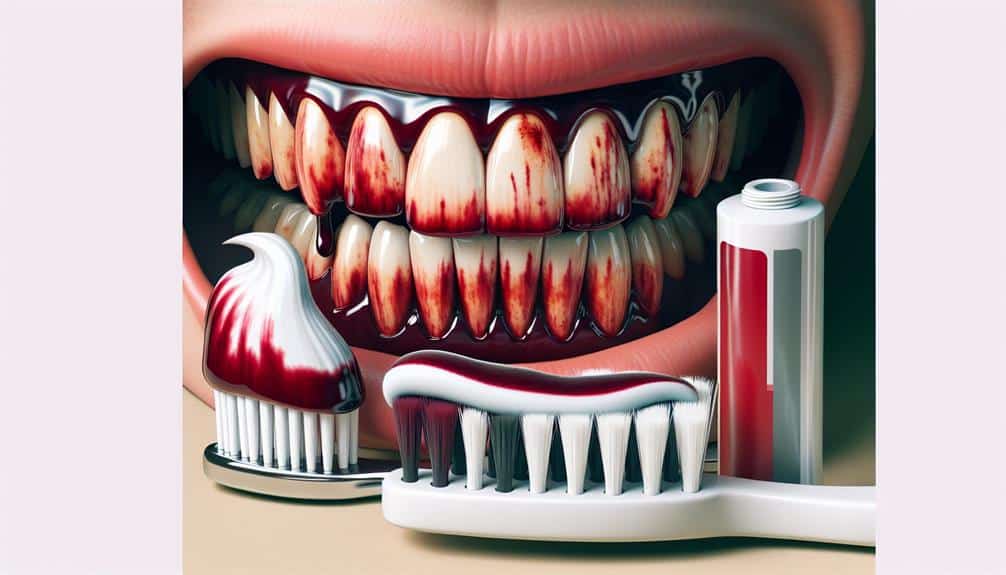To quickly whiten wine-stained teeth, consider these methods. First, mix baking soda and lemon juice to harness their bleaching properties. Swish with coconut oil for 15-20 minutes to combat stains and promote oral health. Try an activated charcoal paste to eliminate surface stains effectively. Remember, consistency is key for noticeable results!
Key Points
- Baking soda and lemon juice mixture for whitening
- Oil pulling with coconut oil combats wine stains
- Activated charcoal paste removes surface wine stains
- Lemon juice's bleaching properties aid in whitening
- Coconut oil reduces bacteria causing staining
Baking Soda and Lemon Juice
To effectively whiten wine-stained teeth, consider using a mixture of baking soda and lemon juice. Lemon juice is a natural bleaching agent that can help lighten stains on teeth. Its acidic nature enhances the whitening properties of baking soda. When combined, they create a gentle yet effective DIY whitening remedy.
The benefits of lemon juice in this mixture lie in its high vitamin C content, which aids in breaking down pigments that cause staining on teeth. Additionally, lemon juice has natural antibacterial properties that can help combat oral bacteria, promoting overall dental health.
To make this whitening paste, mix a small amount of baking soda with freshly squeezed lemon juice to create a smooth consistency. Apply this paste to a toothbrush and gently brush your teeth for about two minutes. Be cautious not to use this remedy more than once a week, as the acidic nature of lemon juice can erode tooth enamel if overused. This simple yet potent method can be a valuable addition to your oral care routine.
Oil Pulling With Coconut Oil
Consider incorporating oil pulling with coconut oil into your oral care routine to help combat wine stains on your teeth effectively. Coconut oil, with its natural antibacterial properties, can aid in reducing bacteria in the mouth that contribute to staining. The benefits of using coconut oil for oil pulling include not only whitening teeth but also promoting overall oral health.
To practice the oil pulling technique with coconut oil, start by taking a tablespoon of coconut oil and swishing it around in your mouth for about 15-20 minutes. Make sure not to swallow the oil, as it will contain bacteria and toxins from your mouth. After swishing, spit out the oil into a trash can and rinse your mouth with water before brushing your teeth as usual.
Regularly incorporating oil pulling with coconut oil into your routine can gradually help diminish wine stains on your teeth while also freshening your breath and promoting healthier gums.
Activated Charcoal Paste
Activated charcoal paste is a popular natural remedy for eliminating surface stains on teeth caused by wine consumption. This black powder is highly absorbent and can bind to substances like tannins found in wine that cause discoloration on your teeth.
To make an activated charcoal paste, mix a small amount of activated charcoal powder with water to form a thick paste. Gently brush this paste onto your teeth, allowing it to sit for a couple of minutes before rinsing thoroughly.
When using activated charcoal paste for teeth whitening, it's important to remember that this method is more effective for removing surface stains rather than deep-seated discoloration. Additionally, excessive use of activated charcoal may wear down the enamel of your teeth over time, so it's best to use this treatment sparingly.
Incorporating activated charcoal paste into your oral hygiene routine once a week can help maintain a bright smile by removing external stains caused by wine and other pigmented foods. Remember to always follow up with regular brushing and flossing for excellent oral health.
Frequently Asked Questions
Can Whitening Toothpaste Be Used in Addition to These Methods for Faster Results?
To speed up results, consider using whitening toothpaste in addition to other methods. It can enhance the whitening process, but be cautious of tooth sensitivity. Brush gently and make sure the toothpaste offers enamel protection for effective and safe results.
Are There Any Long-Term Effects on Teeth Enamel From Using These Natural Whitening Methods?
To safeguard enamel, think about long-term impacts of natural remedies for teeth whitening. Proper use can assist in preventing discoloration while maintaining oral health. It is crucial to balance effectiveness with enamel protection for lasting benefits.
How Often Should These Methods Be Used to Maintain White Teeth?
Feeling like a teeth-whitening pro? To maintain that pearly white smile, aim to use whitening techniques about once a month. This frequency strikes a balance between effectiveness and teeth maintenance, keeping your grin sparkling!
Are There Any Specific Foods or Drinks to Avoid to Prevent Future Wine Stains on Teeth?
To prevent future wine stains on teeth, avoid dark, highly pigmented beverages like red wine. Opt for lighter-colored drinks or pair wine with tooth-friendly snacks like cheese. Rinse your mouth with water after consuming to minimize staining.
Can These Methods Be Used on Dental Work Such as Crowns or Veneers?
When contemplating dental work such as crowns or veneers, it's crucial to be mindful of the limitations of whitening methods. Consult a cosmetic dentist to explore appropriate options for preserving your dental work while still achieving a brighter smile.



